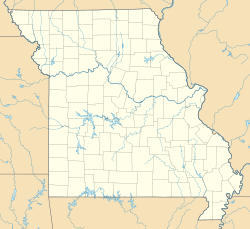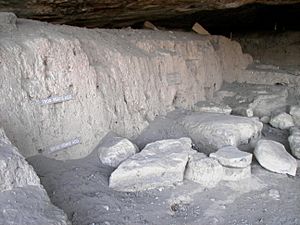Graham Cave facts for kids
|
Graham Cave
|
|
 |
|
| Location | Montgomery County, Missouri, United States |
|---|---|
| Nearest city | Mineola, Missouri |
| NRHP reference No. | 66000420 |
Quick facts for kids Significant dates |
|
| Added to NRHP | October 15, 1966 |
| Designated NHL | January 20, 1961 |
Graham Cave is a very important Native American archaeological site located in Montgomery County, Missouri, near Mineola, Missouri. It sits in the hills above the Loutre River and is part of the 356-acre Graham Cave State Park. The entrance of this large sandstone cave looks like a wide arch, about 120 feet (37 meters) wide and 16 feet (5 meters) high.
The cave goes back about 100 feet (30 meters) into the hillside. It has protected a significant archaeological site that shows how ancient people lived. These people belonged to the Dalton and Archaic cultures, and they lived here as far back as 10,000 years ago!
Contents
How Graham Cave Was Formed
Graham Cave was created where two different types of rock meet: Jefferson City dolomite and St. Peter sandstone. Over many years, water flowing and freezing slowly carved out and expanded the cave.
Originally, the cave stretched about 100 feet (30 meters) deep into the hill. But over time, about seven feet (2 meters) of dirt, rocks, and other materials built up on the cave floor. With its wide opening, the cave offered a great shelter for both humans and animals.
Early Discoveries and Research
A man named Robert Graham bought the land that included the cave in 1847. His family had settled in the area much earlier, in 1816. Robert's son, D.F. Graham, used the cave to shelter his hogs. While doing so, he found many interesting old objects, which made him curious about archaeology.
After D.F. Graham passed away, his son Benjamin offered the collection of artifacts to the University of Missouri. In 1930, the university began to study the cave. Later, in 1948, Benjamin's son-in-law planned to make the cave bigger for his farm animals. Luckily, he was convinced to wait so that archaeologists could do more digging.
Important Archaeological Finds
Between 1949 and 1961, the University of Missouri and the Missouri Archaeological Society worked together to dig deeper into Graham Cave. These excavations uncovered amazing clues about the daily lives of the Dalton and Archaic Native Americans who lived there.
The discoveries were so important that Graham Cave became the very first archaeological site in the United States to be named a National Historic Landmark. This means it's a place of great historical value to the entire country.
Many reports about the findings were published. W. D. Logan wrote the first report in 1952, and Walter Klippel published another in 1971. Famous professors like Carl Chapman, and O'Brien and Wood, also wrote about Graham Cave in their books on Missouri's ancient history.
Graham Cave State Park Today
Today, Graham Cave is part of a 370-acre (1.5 km2) state park. The Missouri Department of Natural Resources manages the park. Visitors can walk up to the entrance of the cave. There are special signs that explain the important archaeological discoveries made there, helping everyone learn about the ancient history of this special place.




